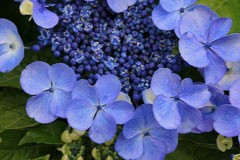
Rudbeckia maxima
Fantastic perennial unlike anything else. Large yellow sombrero-shaped daisies on 1.8 metre stems with large blue grey leaves. Focal point for the back of a mixed border or a feature in a prairie garden.


Medium hydrangea with large heads of blue lacecaps. Note all blue hydrangea need acid soil to produce correct colouring; in alkaline soil they will tend toward pink.
Medium hydrangea with large heads of blue lacecaps. Note all blue hydrangea need acid soil to produce correct colouring; in alkaline soil they will tend toward pink.
Hydrangea 'Blauling' at Woodbridge Nursery Tasmania
Hydrangea 'Blauling' is a deciduous shrub, shedding its leaves in autumn to conserve energy for new growth in spring. Its charming blooms stand out against lush green foliage during the growing season, creating a stunning visual display in gardens and landscapes.
To ensure the optimal coloration, grow Hydrangea 'Blauling' in acidic soil, preserving its tranquil blue pigmentation. In alkaline soil, the blooms may shift to shades of pink, offering a delightful variation to garden aesthetics.
Suggested Uses: Hydrangea 'Blauling' is a versatile addition, suitable for containers, flower arrangements, beds, borders, and informal cottage gardens. It thrives in both urban and city landscapes, requiring minimal maintenance.
Additional information:
Unveil the enchanting world of Hydrangea 'Blauling,' a medium-sized hydrangea variety at Woodbridge Nursery in Tasmania.
Data sheet
Fantastic perennial unlike anything else. Large yellow sombrero-shaped daisies on 1.8 metre stems with large blue grey leaves. Focal point for the back of a mixed border or a feature in a prairie garden.
A robust self supporting Nepeta for the sunny border flowering for most of summer. Easier to manage than N. "Six Hills Giant" and great for mass plantings in place of lavenders.
Perennial wallflower that begins purple and transforms to apricot peachy tones as the flowers age, giving a lovely effect. Winter flowering, bird and butterfly attracting, fragrant.
Brightly coloured old fashioned cushion plant for border and rock garden, often known as 'thrift'. Often associated with coastal gardens, armeria thrive in a wide range of habitat and are both drought and frost tolerant.
A beautiful woodland plant for shade or dappled sun with finely dissected foliage and white early summer flowers. Slow growing but long lived and extremely cold hardy to -15. Prefers good soil and moisture.
A wonderful Geum kept in circulation by Dennis Norgate; vibrant tangerine orange, repeat flowers throughout the year and non seeding.
A sub-species of Salvia nemorosa with larger leaves and flowers than the usual.
Improved form with wider leaf blades than the species and larger inflorescence. A beautiful plant for larger spaces.
A beautiful Allium x rosenbachianum cultivar with tall stems topped with purple spherical flowers, requires good drainage in sun and to dry off in summer
White outward-facing bell flowers clustered on tall stems over a rosette of bright green foliage make this a very attractive garden plant. A suitable ground-cover for colonising difficult areas, particularly in the wild garden where it can be left to ramble freely.
Low growing variety with pink tinged foliage, bee attracting summer flowering.
Often listed incorrectly as Pratia puberula; indigenous to NSW, a vigourous trailing groundcover for shady areas. Effective at suppressing weeds and performs well as mass plantings, starry light blue campanulate flowers borne over a long period. Use in combinaton with viola, epimedium, hosta.
A local plant Ive always loved on the roadsides in summer on Bruny, flowering creamy white in massed colonies. A worthwhile addition to summer perennial plantings with sedums, austrostipa, agastache, and miscanthus. Lower growing and more slender than many other grasses.
Ornamental bronze tinged foliage plant for pond margins and clay soils; associates well with gunnera, filipendula, and Iris. Best in part shade, native to China and Japan.
A lovely species from Greece, useful as a ground-cover for part-sun with attractive velvety leaves. All the attributes of above with white flowers and contrasting red stamens. The foliage colours well in cold winter areas.
Aquilegia caerulea cultivar, long spurred coral red flowers with white centres.

Medium hydrangea with large heads of blue lacecaps. Note all blue hydrangea need acid soil to produce correct colouring; in alkaline soil they will tend toward pink.